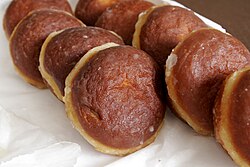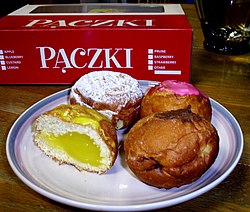Pączki
This article needs additional citations for verification. (February 2008) |


Pączki (Template:Lang-pl, pronounced: [ˈpɔ̃t͡ʂkʲi] MP3 Pronunciation File) are traditional Polish doughnuts. Pączki is the plural form of the word pączek (pronounced: [ˈpɔ̃t͡ʂɛk]) in Polish, though many English speakers use pączki as singular and pączkis as plural.
Typical pączki
A pączek is a deep-fried piece of dough shaped into a flattened sphere and filled with confiture or other sweet filling. Pączki are usually covered with powdered sugar, icing or bits of dried orange zest.
Although they look like bismarcks or jelly doughnuts, pączki are made from especially rich dough containing eggs, fats, sugar and sometimes milk. They feature a variety of fruit and creme fillings and can be glazed, or covered with granulated or powdered sugar. Prunes and rose-petal jam [citation needed] are traditional fillings, but many others are used as well, including lemon, strawberry, Bavarian cream, blueberry, custard, raspberry and apple.
Pączki have been known in Poland at least since the Middle Ages. Jędrzej Kitowicz has described that during the reign of August III, under the influence of French cooks who came to Poland, pączki dough was improved, so that pączki became lighter, spongier, and more resilient.
Pączki Day
In Poland, they are eaten especially on Fat Thursday, the last Thursday before Lent (Polish: Tłusty czwartek, not to be confused with Fat Tuesday or Shrove Tuesday). Traditionally, the reason for making pączki was to use up all the lard, sugar, eggs and fruit in the house, which are forbidden during Lent.
Due to New Orleans' influence, in America, pączki are eaten on Mardi Gras (Fat Tuesday) rather than on Fat Thursday. In the large Polish community of Chicago, and other large cities across the Midwest, Pączki Day is also celebrated annually by immigrants and locals alike. In Buffalo, Cleveland, Detroit, Hamtramck, Milwaukee, and South Bend, Pączki Day is more commonly celebrated on Fat Tuesday instead of Fat Thursday. Chicago celebrates both Fat Thursday and Fat Tuesday, due to its sizable Polish population.
In Hamtramck, an enclave in Detroit, there is an annual Pączki Day (Fat Tuesday) Parade, and lines at bakeries can be seen up to 24 hours before the deep-fried delights go on sale Tuesday morning. The same thing happens also in Cleveland or Garfield Heights, Ohio, outside the Charles Peters Bakery, which is near the border of both cities (at the triple intersection of Turney Road, Grand Division and Sladden Avenue). According to Garfield Heights police, one year 3,000 people waited for pączki. Police had to close Sladden Avenue, and Rybicki and Son Funeral Home had to delay funerals due to this. Many bars in town open early in the morning and provide free entertainment, a party atmosphere, pączki-clad mascots and, in at least one bar, pączki filled with Jagermeister. The Pączki Day celebration in these areas are even larger than many celebrate for St. Patrick's Day.
Pączki in America
These pastries have become popular in the United States as a result of Polish immigrants and marketing by the bakery industry.

A cultural phenomenon is the emergence of the "Pączki Challenge",[citation needed] an eating contest in which individuals attempt to race from one side of a room (non-standard) while eating as many pączki as they can before reaching the other side. The person who arrives first and has eaten the most pączki wins. Typically a ratio of 1 pączek for every 10 steps is considered competitive. Amateur competitive eater McKay Johnson holds the record at The Greater Chicago Paczki Challenge. He was able to consume 18 raspberry filled pączki before crossing the room.
Pączki in Israel
Meanwhile, Polish Jews fried pączki (Yiddish: פּאָנטשקעס , pontshkes) in oil, and ate them on Hanukkah[citation needed]; this custom was imported to Israel and spread to other Jews, who know them by their Modern Hebrew name, סופגניות, sufganiyot (singular: סופגניה, sufganiyah).
Pączki variations worldwide
In Iran, they are called "Pi-rash-ki" and are very popular, especially among the children.
In Russian cuisine, the word "pączki" transformed phonetically into ponchiki (Russian: пончики, plural form of пончик, ponchik) or pyshki (Russian: пышки, especially in St. Petersburg). Ponchiki are a very popular sweet doughnut, with many fast and simple recipes available in Russian cookbooks for making them at home as a breakfast or coffee pastry.[1]
In Ukrainian cuisine, they are called пампушки, pampushky.
In German and Danish, they are called Berliner. In Austria they are called Krapfen.
In Lithuanian cuisine, they're called spurgos.
In Portuguese tradition, a similar confection called the malasada is made during Fat Tuesday. In Hawaii, where Portuguese immigrants worked the sugarcane and pineapple plantations, malasadas are a popular breakfast or dessert item that can be purchased at countless malasada bakeries.
In Brazil, it's called Sonho - Portuguese for "dream".
In Chile, it's called berlín - Spanish for "berliner".
In Hungarian, it is called fánk.
In Italy they are called bomboloni.
References
See also
External links
- Paczki Day PSA, an account of Detroit area Paczki Day traditions in 2008
